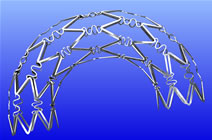|
First Attempts to Treat In-Stent Restenosis Potential fixes for patients coming back to the cath lab were tried, first with balloon angioplasty, where a balloon was inserted and inflated inside the blocked stent. Result were mixed. A more sophisticated (and expensive) approach was developed using radiation in a procedure called brachytherapy. It was thought that irradiating the tissue would suppress re-growth inside the stent. Results were also mixed and the promise of this technology disappeared as the manufacturers of the equipment discontinued production. With the development of the drug-eluting stent (DES), a new kind of stent that emitted a drug to suppress tissue re-growth, cardiologists began placing a stent within a stent, and the results were encouraging. But until now, the data around safety and effectiveness have only reached periods of a year or less. Results of the TRUE Registry: Effectiveness
and Safety At one year, the treatment was 95% successful: only 5 patients out of 100 needed to have another procedure to re-open the artery (and all but one had this done in the cath lab). After four years, only another 6% had re-blockages occur, making for a total restenosis rate after four years of 11%. The safety of drug-eluting stents has been an issue since the initial concerns about late stent thrombosis surfaced back in 2006. It was thought that something about these devices caused blood to clot inside the stent more frequently. The percentage of increase was small, but the results of a stent thrombosis can be devastating, causing death or heart attack half of the time. With the situation of a stent-within-a-stent, the concern was even higher, one reason why the treatment of ISR with a drug-eluting stent is an "off label" indication. However, only 7 patients had a stent thrombosis after four years (5 definite / 2 possible) for a stent thrombosis rate of 2.8%. At the end of the four years, one in ten patients had died, although less than half were from a cardiac-related cause. 80% of the patients remained free from any major adverse cardiac event. These results are similar to those from other ISR studies, albeit none tracked patients for this long. This study only used sirolimus-eluting stents (e.g. CYPHER). Whether or not other types of drug-eluting stents would have similar results cannot be extrapolated from this data. Reported by Burt Cohen, February 10, 2010 |

